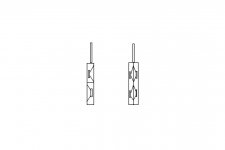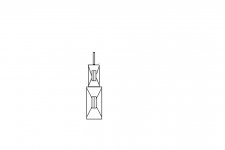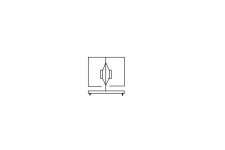tinitus said:Im surpriced to see a pushpull dipole work like that(link) 🙄
The situation is shown in a highly simplified way of course. But as I have learned from my own writings: It's always better to concentrate on the target effect or property and not try to be true to every detail around it.
What's your idea of showing it better?
Rudolf said:
What's your idea of showing it better?
I dont know really

But the two pushpull woofers are shown with a clean common "output"
I would expect there would be severe phase issues between them
But I dont doubt your point about the issue, it makes perfect sense
Not really sure whether something like this one will solve anything either🙄
Another question is how important the backwave really is ?
Maybe its where a ripole has its advantage, having symmetric front and back ?
Attachments
I promised measurements!
Here is the first one, showing bass response in the listening position. Measurement is done with sinewave, no gating or smoothing.
I have closed box subwoofers crossed in at 25 Hz (yes, *that* low). There is very little woofer EQ, apart from the dipole compensation EQ. I've boosted 3 dB at 200 Hz because the 21" driver itself does have a dip there (can be seen on Beyma's own measurements as well).
Here is the first one, showing bass response in the listening position. Measurement is done with sinewave, no gating or smoothing.
I have closed box subwoofers crossed in at 25 Hz (yes, *that* low). There is very little woofer EQ, apart from the dipole compensation EQ. I've boosted 3 dB at 200 Hz because the 21" driver itself does have a dip there (can be seen on Beyma's own measurements as well).
An externally hosted image should be here but it was not working when we last tested it.
Here's also a photo of the setup with the four 18" closed box subs with Beyma 18P1200Nd drivers.
An externally hosted image should be here but it was not working when we last tested it.
Looks nice Stig
Those sharp edges should show on measurements
Could be interesting to see what happens if you put on some felt around the sides
btw, according to some its better to spread out the subs
Those sharp edges should show on measurements
Could be interesting to see what happens if you put on some felt around the sides
btw, according to some its better to spread out the subs
Thanks!
Where should the felt go?
The subs are mainly working below the lowest room mode (25 Hz), that is the room's pressure zone where there are no standing wave modes. Scattered placement dont improve things at these frequencies, only placement near boundaries are useful to gain a little level.
Where should the felt go?
The subs are mainly working below the lowest room mode (25 Hz), that is the room's pressure zone where there are no standing wave modes. Scattered placement dont improve things at these frequencies, only placement near boundaries are useful to gain a little level.
I did test large thick foam pieces on the baffle edges around the tweeter to see if I could improve its off-axis response. Didnt have any effect there. Dampening the front baffle attenuated somewhat below 3 kHz, but not any other effects were observed.
Hmm, ok
Could it be due to the EQ you use ?
Or maybe the low xo point on mid ?
But thanks for response
Could it be due to the EQ you use ?
Or maybe the low xo point on mid ?
But thanks for response
StigErik said:I promised measurements!
Here is the first one, showing bass response in the listening position. Measurement is done with sinewave, no gating or smoothing.
I have closed box subwoofers crossed in at 25 Hz (yes, *that* low). There is very little woofer EQ, apart from the dipole compensation EQ. I've boosted 3 dB at 200 Hz because the 21" driver itself does have a dip there (can be seen on Beyma's own measurements as well).
An externally hosted image should be here but it was not working when we last tested it.
Wow, excellent in room curves! Congrats.... I bet the sound is tight and punchy....
StigErik said:Here's also a photo of the setup with the four 18" closed box subs with Beyma 18P1200Nd drivers.
impressive !
As I don't think you add a sub below 25Hz for the fun of showing such traces only 😉 – may I ask you to tell us more about the difference in *listening fun* with and without your sub's?
🙂
Michael
The subs dont add much with most music, but they give a little more "floor" on grand piano, bass drum and orchestral works to name a few things. And they can reproduce low tones from pipe organ and synthesizers that the dipoles simply cant.
VERY nice Stig 🙂
What are the filters and the crossover parameters ... interested in how much PEQ applied to each of the three drivers, and slopes of the crossovers and shelves
What are the filters and the crossover parameters ... interested in how much PEQ applied to each of the three drivers, and slopes of the crossovers and shelves
All XO filters are linear phase digital filters with a Q of 2. Its a bit like 24 dB/oct, only without the phase shift. XO frequencies are 25, 300 and 1550 Hz.
There is a lot of EQ on the mid and tweeter to get it ruler-flat, but not so much on the woofer, and no EQ on the subs.
The pictures below show EQ curves for tweeter, mid and woofer.
There is a lot of EQ on the mid and tweeter to get it ruler-flat, but not so much on the woofer, and no EQ on the subs.
The pictures below show EQ curves for tweeter, mid and woofer.
An externally hosted image should be here but it was not working when we last tested it.
An externally hosted image should be here but it was not working when we last tested it.
An externally hosted image should be here but it was not working when we last tested it.
I like your setup!
Do you find your computer easy to use? I use Allocator to do the same, and it was really a pain to setup. I'm still not 100% happy with it. Computers just seem overall unreliable to me, although things sound really good right now.
How much CPU power do you use?
Do you find your computer easy to use? I use Allocator to do the same, and it was really a pain to setup. I'm still not 100% happy with it. Computers just seem overall unreliable to me, although things sound really good right now.
How much CPU power do you use?
I find the computer XO solution very easy and simple to use, maybe because I've been using it for a long time and I've worked with computer audio for 15 years or so.
I did have a lot of stability issues, but all were related to bad hardware drivers (for the RME Fireface 800). I've tuned the computer somewhat down to a minimum setup - disabled services not needed, no antivirus software, as few programs as possible installed and so on. That helps stability.
My XO runs at 44.1 kHz sample rate, and uses about 33% CPU on my Core Duo 1.8 GHz machine.
I did have a lot of stability issues, but all were related to bad hardware drivers (for the RME Fireface 800). I've tuned the computer somewhat down to a minimum setup - disabled services not needed, no antivirus software, as few programs as possible installed and so on. That helps stability.
My XO runs at 44.1 kHz sample rate, and uses about 33% CPU on my Core Duo 1.8 GHz machine.
cuibono said:I like your setup!
Do you find your computer easy to use? I use Allocator to do the same, and it was really a pain to setup. I'm still not 100% happy with it. Computers just seem overall unreliable to me, although things sound really good right now.
How much CPU power do you use?
Exactly - sound simply is great, no way to beat IMO - but reliability is the main drawback with PC XO and you have to pay a looot of attention in this department to take that hurdle.
From my own experiance and what I've been suggsted (having got a lot of help and good ideas from Eric and Shinobivan here) there are a few guidelines to overcome the PC issue
- use a dedicated PC – meaning no other things to do or being installed on that machine other than audio processing (and measurement if needed) – this is an investment that's worth every penny IMO – install OS from scratch and do not do any further updates once its running smoothly
- the PC used *must* stay cool – meaning don't go with a overclocking-super-duper-machine
- don't connect to any network whatsoever – use USB sticks to transfer any data needed
- use peripheral units that have proven to be reliable both in hardware and in software (drivers)
- avoid to use the "latest" in OS – these most likely have issues with driver stability
- just let your setup work lightly - don't try to squeeze the last bit of performance out of it by tweaking and tweaking again
My setup is a cheap Lenovo dual core laptop running XP and console with a Mackie firewire eight channel soundcard attached – and I haven't had issues until – it has proven to be a very lean and reliable setup so far and I try hard to keep it that way.
It took me several month to gain faith in that setup – starting with bass drivers first and integrating mid / high later on - when I got used to that new toy and managed to find a comfortable top quality way to do volume control too.
Michael
- Home
- Loudspeakers
- Multi-Way
- My open baffle dipole with Beyma TPL-150


